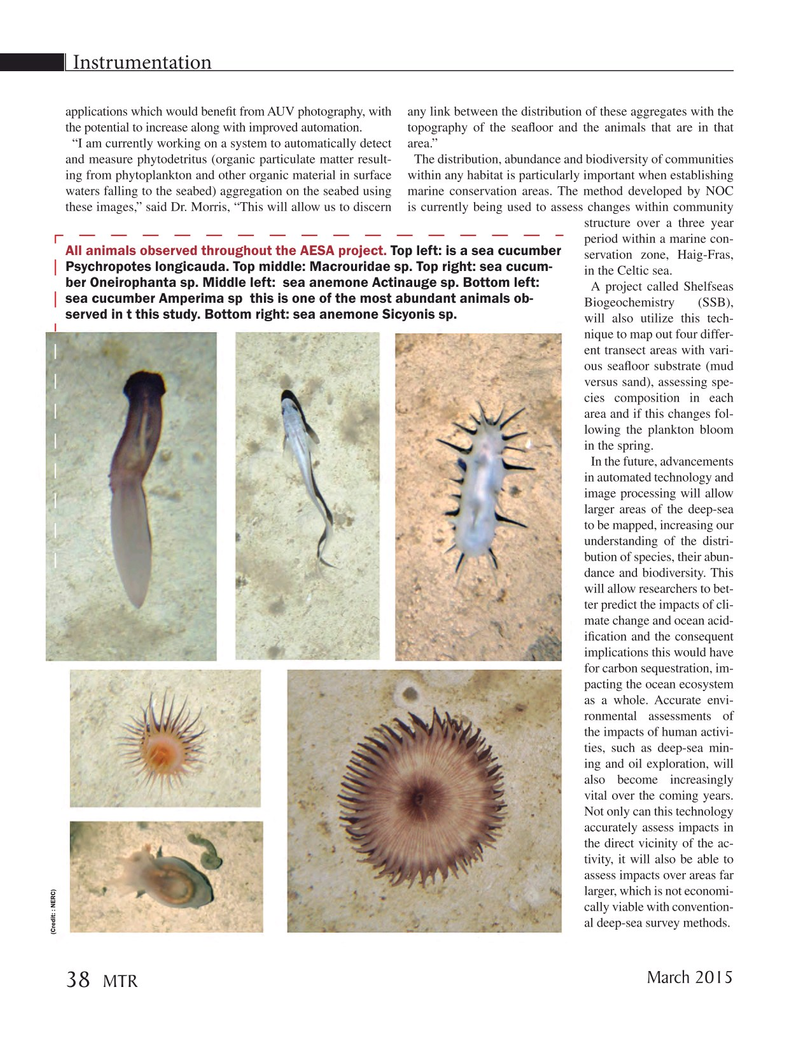
Page 38: of Marine Technology Magazine (March 2015)
Oceanographic Instrumentation: Measurement, Process & Analysis
Read this page in Pdf, Flash or Html5 edition of March 2015 Marine Technology Magazine
Instrumentation applications which would bene? t from AUV photography, with any link between the distribution of these aggregates with the the potential to increase along with improved automation. topography of the sea? oor and the animals that are in that “I am currently working on a system to automatically detect area.” and measure phytodetritus (organic particulate matter result- The distribution, abundance and biodiversity of communities ing from phytoplankton and other organic material in surface within any habitat is particularly important when establishing waters falling to the seabed) aggregation on the seabed using marine conservation areas. The method developed by NOC these images,” said Dr. Morris, “This will allow us to discern is currently being used to assess changes within community structure over a three year period within a marine con-
All animals observed throughout the AESA project. Top left: is a sea cucumber servation zone, Haig-Fras,
Psychropotes longicauda. Top middle: Macrouridae sp. Top right: sea cucum- in the Celtic sea. ber Oneirophanta sp. Middle left: sea anemone Actinauge sp. Bottom left:
A project called Shelfseas sea cucumber Amperima sp this is one of the most abundant animals ob-
Biogeochemistry (SSB), served in t this study. Bottom right: sea anemone Sicyonis sp. will also utilize this tech- nique to map out four differ- ent transect areas with vari- ous sea? oor substrate (mud versus sand), assessing spe- cies composition in each area and if this changes fol- lowing the plankton bloom in the spring.
In the future, advancements in automated technology and image processing will allow larger areas of the deep-sea to be mapped, increasing our understanding of the distri- bution of species, their abun- dance and biodiversity. This will allow researchers to bet- ter predict the impacts of cli- mate change and ocean acid- i? cation and the consequent implications this would have for carbon sequestration, im- pacting the ocean ecosystem as a whole. Accurate envi- ronmental assessments of the impacts of human activi- ties, such as deep-sea min- ing and oil exploration, will also become increasingly vital over the coming years.
Not only can this technology accurately assess impacts in the direct vicinity of the ac- tivity, it will also be able to assess impacts over areas far larger, which is not economi- cally viable with convention- al deep-sea survey methods.
(Credit: : NERC)
March 2015 38
MTR
MTR #2 (34-49).indd 38 MTR #2 (34-49).indd 38 3/8/2015 1:12:21 PM3/8/2015 1:12:21 PM

 37
37

 39
39
